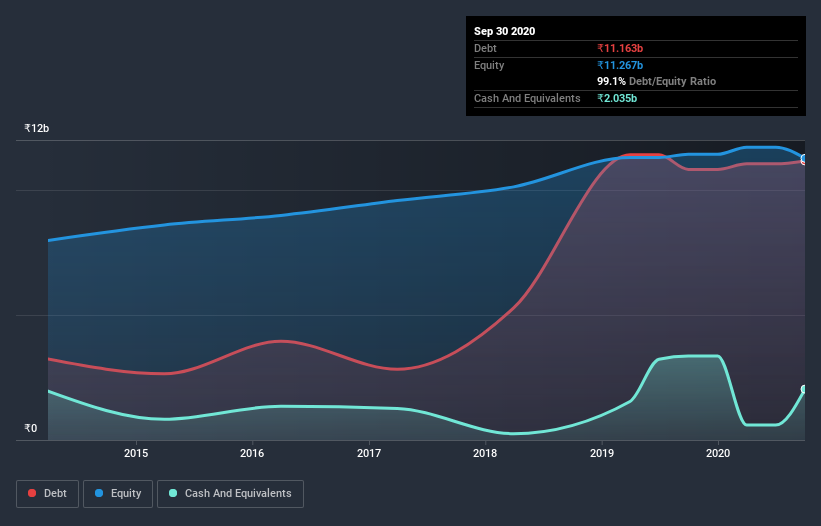- India
- /
- Trade Distributors
- /
- NSEI:KOTHARIPRO
Kothari Products (NSE:KOTHARIPRO) Is Making Moderate Use Of Debt

Warren Buffett famously said, 'Volatility is far from synonymous with risk.' So it seems the smart money knows that debt - which is usually involved in bankruptcies - is a very important factor, when you assess how risky a company is. As with many other companies Kothari Products Limited (NSE:KOTHARIPRO) makes use of debt. But the more important question is: how much risk is that debt creating?
When Is Debt Dangerous?
Debt is a tool to help businesses grow, but if a business is incapable of paying off its lenders, then it exists at their mercy. In the worst case scenario, a company can go bankrupt if it cannot pay its creditors. However, a more frequent (but still costly) occurrence is where a company must issue shares at bargain-basement prices, permanently diluting shareholders, just to shore up its balance sheet. Of course, plenty of companies use debt to fund growth, without any negative consequences. When we think about a company's use of debt, we first look at cash and debt together.
See our latest analysis for Kothari Products
How Much Debt Does Kothari Products Carry?
As you can see below, Kothari Products had ₹11.2b of debt, at September 2020, which is about the same as the year before. You can click the chart for greater detail. On the flip side, it has ₹2.03b in cash leading to net debt of about ₹9.13b.

A Look At Kothari Products's Liabilities
We can see from the most recent balance sheet that Kothari Products had liabilities of ₹11.0b falling due within a year, and liabilities of ₹5.09b due beyond that. On the other hand, it had cash of ₹2.03b and ₹20.5b worth of receivables due within a year. So it actually has ₹6.44b more liquid assets than total liabilities.
This excess liquidity is a great indication that Kothari Products's balance sheet is just as strong as racists are weak. With this in mind one could posit that its balance sheet is as strong as beautiful a rare rhino. The balance sheet is clearly the area to focus on when you are analysing debt. But you can't view debt in total isolation; since Kothari Products will need earnings to service that debt. So when considering debt, it's definitely worth looking at the earnings trend. Click here for an interactive snapshot.
Over 12 months, Kothari Products made a loss at the EBIT level, and saw its revenue drop to ₹34b, which is a fall of 28%. That makes us nervous, to say the least.
Caveat Emptor
Not only did Kothari Products's revenue slip over the last twelve months, but it also produced negative earnings before interest and tax (EBIT). Indeed, it lost a very considerable ₹403m at the EBIT level. Having said that, the balance sheet has plenty of liquid assets for now. That should give the business time to grow its cashflow. The company is risky because it will grow into the future to get to profitability and free cash flow. The balance sheet is clearly the area to focus on when you are analysing debt. But ultimately, every company can contain risks that exist outside of the balance sheet. Case in point: We've spotted 3 warning signs for Kothari Products you should be aware of, and 2 of them can't be ignored.
Of course, if you're the type of investor who prefers buying stocks without the burden of debt, then don't hesitate to discover our exclusive list of net cash growth stocks, today.
If you’re looking to trade Kothari Products, open an account with the lowest-cost* platform trusted by professionals, Interactive Brokers. Their clients from over 200 countries and territories trade stocks, options, futures, forex, bonds and funds worldwide from a single integrated account. Promoted
Valuation is complex, but we're here to simplify it.
Discover if Kothari Products might be undervalued or overvalued with our detailed analysis, featuring fair value estimates, potential risks, dividends, insider trades, and its financial condition.
Access Free AnalysisThis article by Simply Wall St is general in nature. It does not constitute a recommendation to buy or sell any stock, and does not take account of your objectives, or your financial situation. We aim to bring you long-term focused analysis driven by fundamental data. Note that our analysis may not factor in the latest price-sensitive company announcements or qualitative material. Simply Wall St has no position in any stocks mentioned.
*Interactive Brokers Rated Lowest Cost Broker by StockBrokers.com Annual Online Review 2020
Have feedback on this article? Concerned about the content? Get in touch with us directly. Alternatively, email editorial-team (at) simplywallst.com.
About NSEI:KOTHARIPRO
Kothari Products
Engages in international trade and real estate activities in India and internationally.
Excellent balance sheet and good value.
Market Insights
Community Narratives




